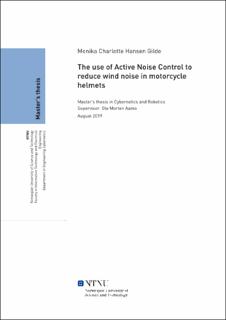| dc.contributor.advisor | Aamo, Ole Morten | |
| dc.contributor.author | Gilde, Monika Charlotte Hansen | |
| dc.date.accessioned | 2019-12-28T15:00:08Z | |
| dc.date.issued | 2019 | |
| dc.identifier | no.ntnu:inspera:35771502:18488061 | |
| dc.identifier.uri | http://hdl.handle.net/11250/2634444 | |
| dc.description.abstract | Motorsykkelryttere som kjører på motorvei blir utsatt for vindstøy som kan vær på opptil 110 dB. Langvarig eksponering for støy kan føre til hørselstap, og støyen hindrer også rytteren i å plukke opp viktig trafikkstøy. Vindstøy kan reduseres ved bruk av en metode kalt aktiv støydempning, forkortet ANC. I denne rapporten blir historien til og prinsippene bak ANC utforsket, i tillegg til forskjellig variasjoner av filtrert minste kvadraters metode, FxLMS. Ulike estimeringsteknikker blir også utforsket, ANC-systemet blir simulert og resultatene diskutert. | |
| dc.description.abstract | Motorcycle riders are exposed to wind noise at highway speeds as loud as 110 dB. Prolonged exposure can lead to hearing loss, and the noise prevents the rider from picking up vital traffic noise. Wind noise can be reduced using active noise control, ANC. In this paper, the history and principle of ANC are explored, as well as different variations on the filtered least means squared algorithm. Some different estimation techniques are also explored, the ANC system is simulated, and the results discussed. | |
| dc.language | eng | |
| dc.publisher | NTNU | |
| dc.title | The use of active noise control to reduce wind noise in motorcycle helmets | |
| dc.type | Master thesis | |
